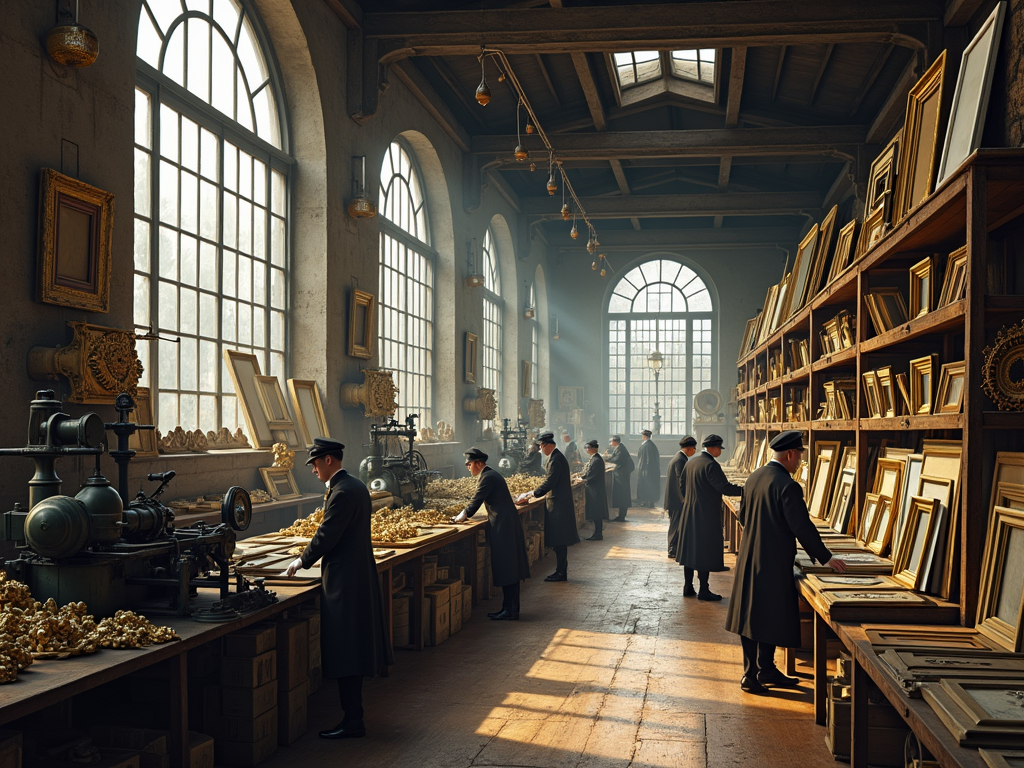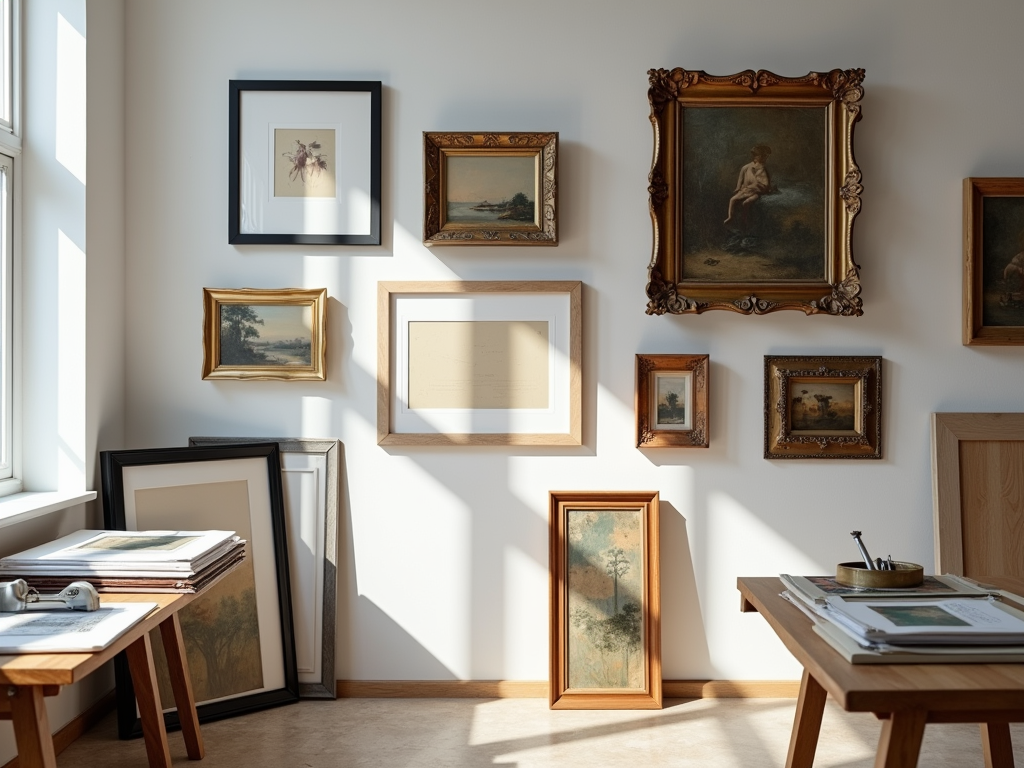
Picture framing has transformed far beyond its original purpose of safeguarding and supporting artwork. It has become an art form that reflects cultural, spiritual, and artistic beliefs throughout history. From the integrated designs of ancient Egypt to the intricate gilded frames of the Renaissance and the clean, modern innovations of today, the story of picture framing parallels humanity’s evolving relationship with creativity and self-expression.
Key Takeaways
- Ancient Egyptian picture frames served more as functional, structural elements, often carved into walls as part of the architecture.
- Frames gained independence during the Middle Ages, especially in religious contexts, where they combined practical use with deeper symbolic meaning.
- Renaissance frames became symbols of status and wealth, with their intricate details and luxurious materials like gold leaf highlighting opulence.
- The Industrial Revolution shifted the focus to affordability and accessibility through mass production, which often came at the expense of handcrafted charm.
- Contemporary frames embrace simplicity while retaining craftsmanship, blending visual elegance with the vital role of preserving the art they hold.
The Evolution of Picture Frames: From Function to Art
Picture frames began as practical tools, created to protect and support artwork. Early frames were simple, often made from wood to anchor stretched canvas or similar materials. Their sole function was to preserve the art, not necessarily enhance it.
In ancient Egypt, frames weren’t distinct objects but integrated directly into architectural designs. Tomb art, for instance, used carved edges around images, blending the “frame” seamlessly with the surrounding structure. It was less about decoration and more about maintaining the sanctity of the imagery.
Fast forward to the Middle Ages, and frames began to stand out in a slightly different manner. Panel paintings, particularly those used in religious settings, started using explicit borders. Think of medieval altarpieces—these frames enclosed the scenes, directing focus while protecting the sacred art inside. They also balanced their utilitarian purpose with the religious symbolism of their surroundings.
The shift towards decorative design came gradually. As techniques improved, frames became works of art in their own right. Still, their initial practicality wasn’t abandoned entirely. By comparing Egyptian carvings to medieval gilded panels, it’s easy to see how frames reflected the aesthetic values of their times while sticking close to functionality.
Even today, I see echoes of these origins when I study contemporary frame-making methods. If you’re curious about their early design or want to recreate something inspired by those styles, you might enjoy exploring the origins of picture frames. They remain a fascinating mix of form and function.
Renaissance Elegance: When Frames Became Symbols of Wealth
During the Renaissance, picture frames became more than just functional borders. They transformed into symbols of wealth and artistic sophistication, tailored to complement the grandeur of the paintings they encased. Wealthy patrons commissioned frames adorned with gilded gold, intricate carving, and at times, inlaid precious stones, each design reflecting their status.
The shift also saw frame-making rise as its own respected craft. Italian designers mastered ornate sculpting, with frames often shimmering in layers of gold leaf. In contrast, the styles in Northern Europe were slightly more restrained, utilizing finer carvings and muted gilding that still matched the elegance of their time.
Famous examples can be seen in Italian chapels, where frames like those around works by Fra Angelico match the opulence of religious murals. For more on how framing evolved over time, check out this detailed look at the origin of picture frames.
Frames during the 17th and 18th centuries weren’t just for holding art—they were an art form in themselves. The baroque and rococo styles heavily influenced their design, with frames mimicking architectural elements like columns, pediments, and intricate moldings. These weren’t just embellishments; they turned the frame into a bold statement, making them as grand as the artwork they encased.
The Opulence of Baroque Frames
Baroque frames, in particular, were unapologetically opulent. Carved details like laurel wreaths or cornucopias were common, reflecting the extravagance and drama of the period’s paintings, which often featured religious or royal themes. Trompe-l’oeil techniques were frequently used to trick the eye, adding depth and making framed pieces feel almost like portals to another reality. This effect wasn’t accidental—it was designed to both enhance the art and create a seamless integration with the ornate interiors where these pieces often hung.
Versailles and Trompe-l’oeil Frames
One striking example is the celebrated trompe-l’oeil frames at Versailles, where their layered carvings and painted effects made them appear almost three-dimensional. Such designs weren’t passive—they actively bridged the art with its surrounding architecture, making it all feel like part of an immersive experience.
Frames as Architectural Extensions
This era essentially treated the frame as an architectural extension, elevating both the art and its setting. If you’re curious about the origins of these artistic innovations, don’t miss this guide on the origin of picture frames. It offers further insights into how frames evolved into the marvels they became during this time.
The Industrial Revolution transformed how frames were made. Machines started replacing hand tools, and suddenly frames weren’t just the result of weeks or months of skillful labor—they could be churned out quickly and at scale. This era introduced new materials like plaster and composition ornaments, which could mimic intricate carvings without requiring a carver’s delicate touch. It wasn’t just about speed, though. These materials were far cheaper than traditional wood and gilding, slashing the cost of production.
Ready-made frames became a game-changer. Images could now be framed on demand, making framing accessible to a broader audience. Instead of commissioning a one-of-a-kind design, people could walk into a store and choose a frame that matched their budget and style. It completely flipped the framing market. While this made art and home décor more democratic, it also meant less work for artisans specializing in handcrafted frames. The unique artistry of highly skilled framemakers started taking a backseat to efficiency and uniformity.
This shift mirrored changing attitudes. There was a surge in mass-produced prints and affordable art, meaning more people could afford to own and display artwork in their homes. Frames, just like the art they held, became symbols of art’s growing accessibility. Handmade, intricate designs didn’t disappear altogether, though. They retained a certain prestige—a nod to their more bespoke heritage. If you’re interested in still making frames yourself, you might check out this guide on exclusive DIY picture frame ideas that blend tradition with adaptability.

Simplicity and Innovation: Framing in Modern Times
The 20th century ushered in minimalist trends, favoring sleek and unadorned frames made of materials like metals and plastics. These frames offered clean lines that complement modern interiors, perfect for putting the focus squarely on the artwork. At the same time, there’s been a resurgence in handcrafted designs, highlighting frames not just as utilities but as art pieces themselves.
Modern practices strike a balance between simplicity and tradition. Thin black or silver aluminum frames are excellent for highlighting photographs or contemporary prints without overpowering them. On the other side, intricately carved wooden frames are often chosen for oil paintings or vintage pieces, adding depth and warmth.
Conservation framing also became a key priority. With specialized archival mats and UV-protective glass, these frames protect artworks from damage while still keeping their aesthetic appeal. You can look into tips on making your own frame to explore creative possibilities.

Sources:
Picture Framing Magazine
The Frame Blog
Metropolitan Museum of Art articles on frames
National Gallery articles on frames
The Art of the Frame by Deborah Davis
